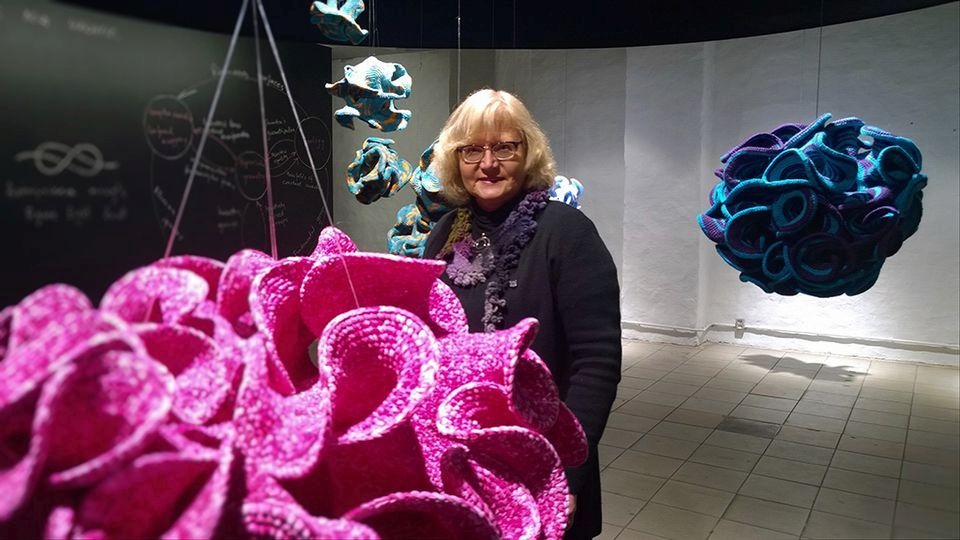
Happy maths
An interview with mathematician and artist Daina Taimiņa
What is a hyperbolic plane? It is more than likely that Daina Taimiņa – a mathematician and artist of Latvian origin living in the USA and an associate professor at Cornell University who has gained wide attention from both mathematicians and the art world – is the best person one could ask to explain the concept. About 25 years ago, while taking a course for university lecturers, she crocheted her first hyperbolic plane out of a desire to understand an object whose essence was a riddle to her. She later crocheted them as a methodological tool to help students understand the properties of hyperbolic geometry, but over time her creations ended up in design museums and they are now part of contemporary art exhibitions. ‘I just completed another group – a whole Hyperbolic Garden for the Mathemalchemy project inspired by Ingrid Daubechies, one of the most popular and well-known mathematicians in the world today. The artistic director of the installation is Canadian textile artist Dominique Ehrmann. In this installation, mathematics will be revealed through various art objects,’ Taimiņa tells me during our conversation. ‘In school I was told that I would never become an artist. In drawing class I was given passable marks out of pity – so that it wouldn’t ruin my otherwise perfect grades’.
Taimiņa’s hyperbolic plane objects have been exhibited more than once in Latvia. In 2014 the exhibition Hyperbolic Planes and Sustainability Networks was held at at the Kim? Contemporary Art Centre, with the support of the RIXC Centre for New Media Culture (among the objects on view was White Cloud, for which Taimiņa organised a social network involving volunteers). This summer, as part of the 2nd Riga International Biennial of Contemporary Art (RIBOCA) titled and suddenly it all blossoms, which will run from August 20 to September 13 in Riga’s Andrejsala quarter, viewers will be able to experience the large-format work Dreams and Memories, which is being created by several hundred crocheters in Latvia as well as Taimiņa’s admirers in other countries.
I spoke with Taimiņa over Skype. Near the end of our conversation she tells me how much she wishes that she could participate in the Biennial in person, but that it’s just not possible with the current situation. Despite the pandemic, crocheters from around the world are still creating hyperbolic plane curlicues up until the deadline of July 13.
How did you spend the spring months of the pandemic, when practically the whole world was under quarantine?
I can finally live the way I’ve always wanted to – I don’t have to go anywhere, I don’t have to see anyone, I don’t have to meet with anyone. I can be just with myself. My husband tragically died in December 2018, and the way I’m living now… Well, it’s the way I wish I could have lived the whole of last year. If everyone could have just left me in peace… But with all of the things I had to put to order and do, that couldn’t be. I’ve finally had the time in which to organise my thoughts, understand how to go forward… I’ve been very self-indulgent. I was actually quite surprised because I had never thought of myself as being so deeply introverted.
Mostly I’ve spent this Covid period right here – working at my husband’s [David W. Henderson’s – ed.] desk in his study, finishing up and getting ready for publication the next, fourth edition, of Experiencing Geometry. It’s a special book, and this year will be the 25th year since its first edition came out – David and I met in Sicily just after it had come out in 1995. We both began to work on this fourth edition, and I understood that I had to continue with it. The book has now become a commemorative edition. I will also follow my husband’s wishes that the book will be available free of charge on the internet, i.e. open access. It’s kind of a gift to all of his students and admirers because the situation with the book overall has become nearly absurd, and so it’s also our protest against the politics of academic publishing. If you look at the book’s current price on the internet, the cheapest is about 200 dollars. Used copies are being sold, and they’re also being rented out. In the end, the price of the book is greater than our royalties, which were 150 dollars a year.
Colourful and rich hyperbolic contributions to “Dreams and Memories” project at RIBOCA2 by Daina Taimiņa.
That’s capitalism for you.
Exactly. And it’s why I told the publishers: ‘No, you are not going to make money off of this.’ So the book will be available to all for free on the Project Euclid website, which already has David’s Differential Geometry.
In 2009 you wrote another book, Crocheting Adventures with Hyperbolic Planes. In the foreword, renowned mathematician Bill Thurston writes that mathematics is an art of humanity’s understanding. Is it possible to explain this pandemic from the viewpoint of mathematics? How many unknowns are there in the world of mathematics?
It can definitely be explained. In the same way that my hyperbolic planes grow in size, so does the virus spread exponentially. People who crochet can perfectly understand how that happens. Many mathematicians were involved in creating mathematical models to analyse how the virus spreads and to predict its course. Here in America, before the virus spread, mathematicians outlined what would happen if nothing was done, and that if no effort was made to stop it, there would be a high mortality rate. Unfortunately, the president cared more about his political interests than the opinion of scientists, and he said that that won’t happen. But it did. And it’s been even worse.
Colourful and rich hyperbolic contributions to “Dreams and Memories” project at RIBOCA2 by Daina Taimiņa.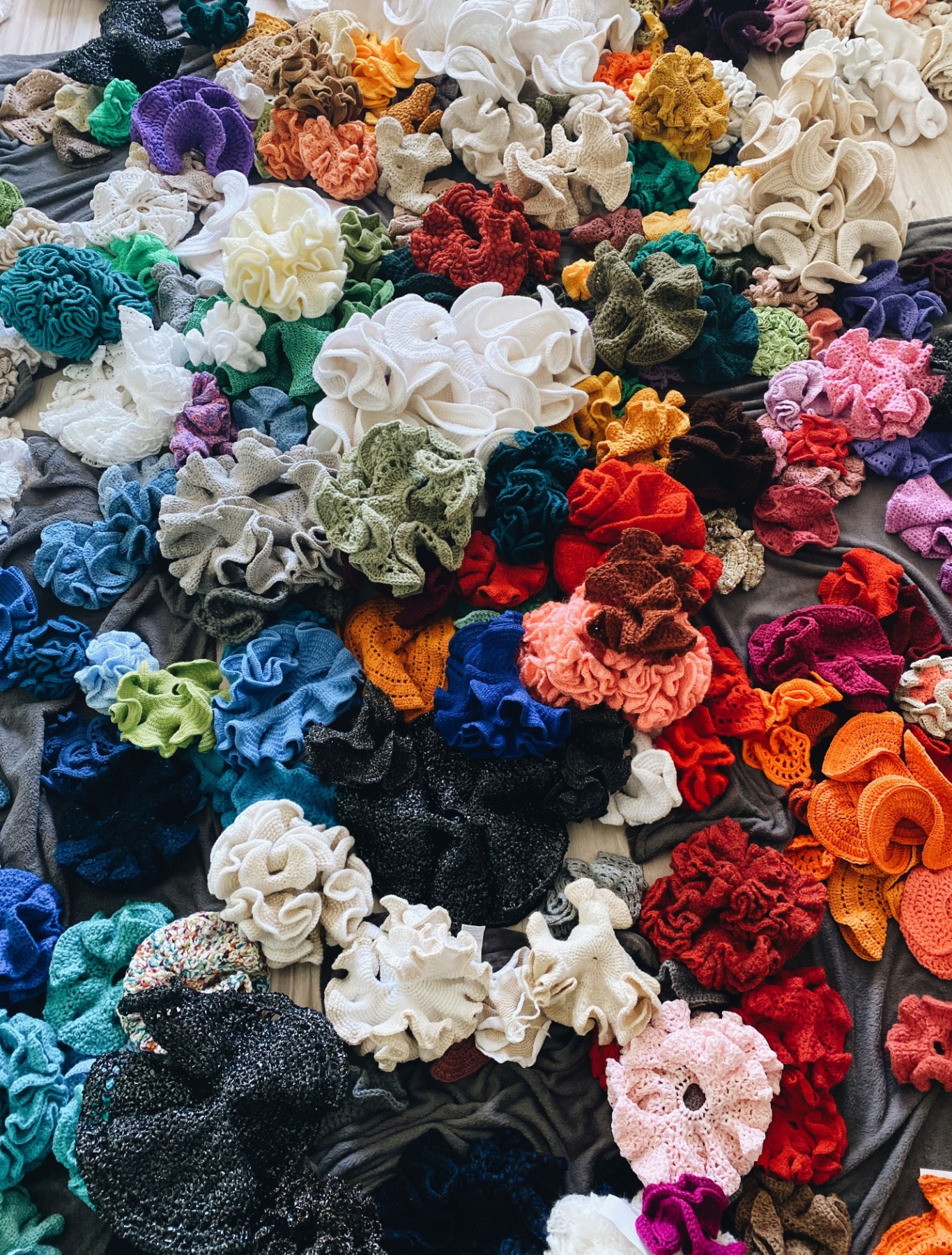
But there are always gaps in our knowledge, and some things will always remain unknown. Simply because everything changes and develops and there are twists and turns both in life and in our ways of thinking, and new problems are always arising for us to solve. In 2018 the second edition of my book came out, and just like with the first one, the typesetting for its publishing was done by my husband. I dedicated the second edition to Bill Thurston, my husband, and my maths teacher, Alfrēds Grava – three people who showed be the beauty of geometry.
There are always gaps in our knowledge, and some things will always remain unknown.
The same could be said of non-Euclidean geometry, which also includes hyperbolic geometry (and your crocheted planes) and is still not taught in school; compared to Euclidean geometry, it is a new phenomenon.
Yes. That’s how it is with non-Euclidean geometry. If there is a model (in the traditional school of thought these are the Euclidean postulates) and if this model is followed, everything seems to go according to a certain order. Just like in society, where there are certain rules. But then someone imagines – what would happen if I change something? If I did things differently? And that’s what happened with Euclid's postulates. The fifth one [If two lines are drawn which intersect a third in such a way that the sum of the inner angles on one side is less than two right angles, then the two lines inevitably must intersect each other on that side if extended far enough. – ed.] seemed very suspicious – already in the 14th and 15th centuries, especially in the East where they had Islamic mathematics, people were doubting it. One of them was Omar Khayyam, who studied what would happen if we ignore this postulate. There’s a thing called a Khayyam parallelogram. In Latvia he is better known as a poet, but he was actually a mathematician. Of course, there’s always this hesitancy, a fear of breaking rules. Finally, at the beginning of the 19th century, Carl Friedrich Gauss began to think about the curvature of a surface, about how one could mathematically describe and discern two-dimensional surfaces that are flat from those that are curved. He figure that this should be done numerically because it would be easier to understand. If something is flat, then it has a curvature of zero. If something is round, then we can grasp it in different ways, but both hands will always be facing in the same direction. This is similar to a positive multiplied by a positive or a negative multiplied by a negative – in both cases, the product is positive and therefore round. But there is another variant – the hyperbolic plane. When you try to grasp it, one hand will go up and the other will go down. So this curvature will be negative. Gauss was already the king of mathematics at that time. It is difficult for a person with a huge reputation, and whom everyone listens to, to come out with something heretical – not to mention that it was also contradictory to Kant's philosophy, which is based on Euclidean geometry... To come out with a bold idea and challenge everything that has been accepted would be a really revolutionary act, even heresy. As a result, Gauss did mention his thoughts to someone else, but that was all. And then the young János Bolyai came along – his father had been a friend and classmate of Gauss – and dared to do what Gauss had not [János’s 1896 work, Appendix Explaining the Absolutely True Science of Space, was written as a supplement to a book written by his father, Farkas Bolyai, in 1831.) János’s father did try to dissuade him from the endeavour, saying that he had already attempted to ‘traverse this bottomless night, which extinguished all light and joy in my life’. Around the same time, Lobachevsky developed the same idea completely independently in Kazan [Russia]. But Lobachevsky (also understanding that Euclid’s fifth postulate was not true) wasn’t thinking from the point of view of a curved surface but instead referenced the stars. I remember having to learn Lobachevskian geometry at university. The lecturer suggested that we try to imagine two straight lines that converge and diverge. I just couldn’t get my head around this. I guess that the Euclidean postulates and the fact that ‘it is so’ had been driven into me so deeply that I simply could not comprehend it back then. Of course, students being students will commit to memory anything just to get a grade. But later, that was the reason I began to crochet my hyperbolic planes. You can see the straight line simply by folding it like a sheet of paper, and everything then becomes clear. This is because both Euclidean and hyperbolic planes have line symmetry.
Colourful and rich hyperbolic contributions to “Dreams and Memories” project at RIBOCA2 by Daina Taimiņa.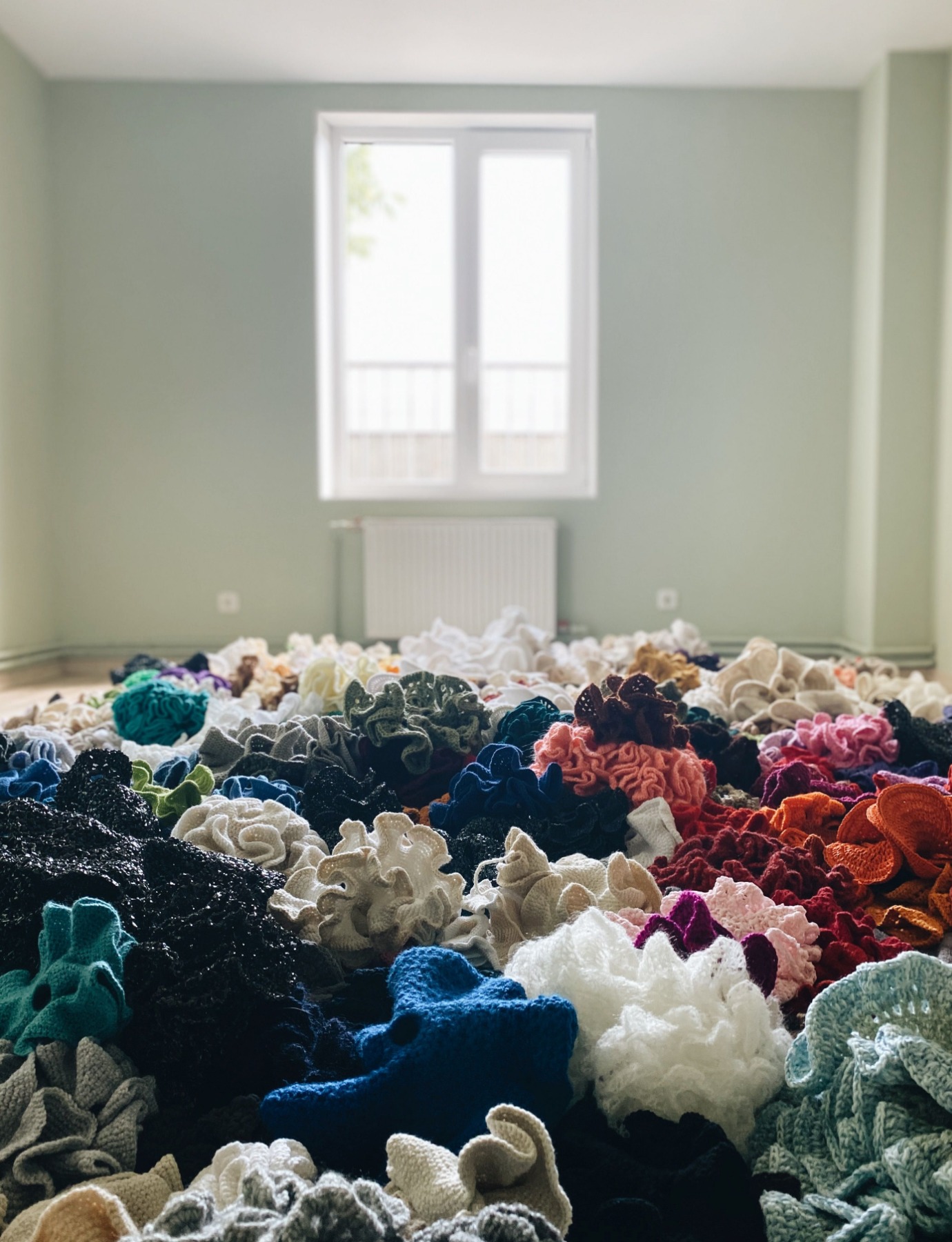
Mathematics has always had a special relationship with art – you write a lot about this in Crocheting Adventures with Hyperbolic Planes. Non-Euclidean geometry is also closely related to Cubism.
Yes, in the early 20th century there were people who wanted to break artistic stereotypes, and non-Euclidean geometry helped them a lot with their ideas. In painting, the linear perspective is widely used – that is, parallel lines are depicted as lines that intersect at the horizon. But in non-Euclidean geometry, these line will not intersect, so there was even a slogan – away with perspective! A great book on that is Linda Henderson’s (no relation to my husband) Fourth Dimension and nonEuclidean geometry in Modern Art.
In the early 20th century there were people who wanted to break artistic stereotypes, and non-Euclidean geometry helped them a lot with their ideas.
Hyperbolic planes are also one of the most vivid elements featured in the architecture of today.
Those are not quite hyperbolic planes – surfaces with a negative curvature would be more accurate. I have a friend, the architect Gisela Baurmann, with whom I have worked together and who uses crochet to help her students understand and sense space in a tactile way.
Daina Taimiņa. Installation White Cloud (2014). Various materials. Approximately 1.5x1.5x2 m
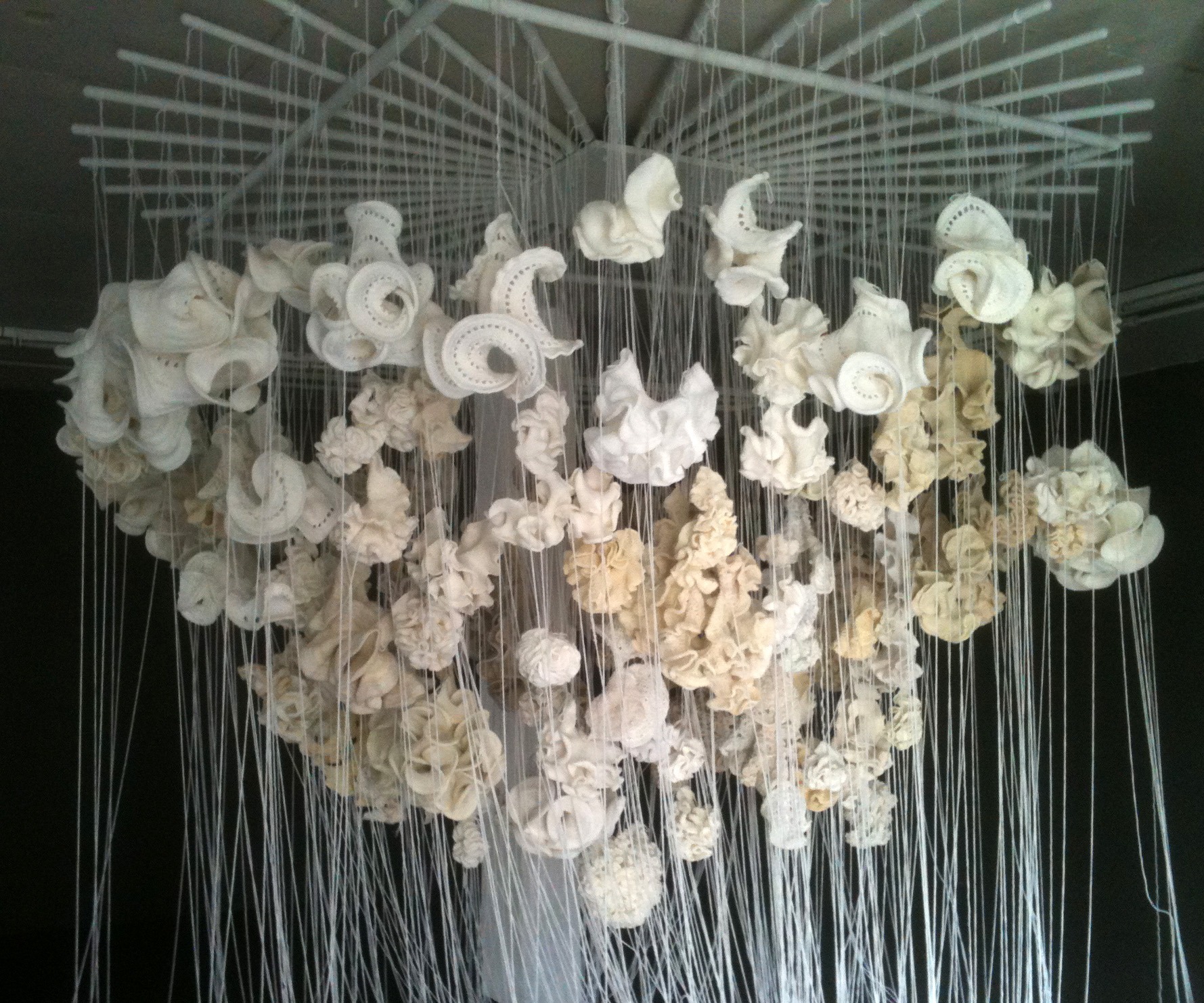
Zaha Hadid was an architect who was particularly fascinated with surfaces with negative curvature.
Yes, she did so actively and sometimes with amazing boldness. Excellent architecture. If you ever arrive in New York through JFK International Airport and you have the time, head to Terminal 5, where you can finally enter the TWA Hotel [formerly the TWA Flight Center designed by Eero Saarinen – ed.], which was built in the 1960s. This is something really fabulous. There are no straight lines.
As you say yourself, as a student, hyperbolic planes did not grab your attention. Why did you return to them? It’s been thanks to hyperbolic planes, after all, that you’ve become famous in the worlds of both art and mathematics.
When I graduated from university in Latvia and had finally rid myself of those planes, I most likely wouldn't have had to do anything with them in my later life. I worked at the University of Latvia for twenty years and had nothing do with non-Euclidean geometry. But then, in late 1996 I came here – to Cornell – where I was offered a teaching job. And one of the courses I taught used the first edition of my husband’s book that I mentioned earlier, which covered all three geometries: plane, spherical, and hyperbolic. My husband taught courses on how to teach these geometries, which back then were not even taught in high school. Now there's a requirement for high school courses to at least mention that such a thing as non-Euclidean geometry exists. After all, it is the basis of the Theory of Relativity, and such things must be covered in school. It was during this teaching course that I first saw the hyperbolic plane model made of paper that now stands here, on a shelf in my home, which David used to illustrate to us what a hyperbolic plane could look like. But it’s so fragile that you can’t take it in your hands and manipulate it. I really, really wanted to fold it and see how the lines form. So I looked at it and thought, hey, this could be knit. I'm more of a knitter than a crocheter, but it turned out that there were too many stitches involved for knitting. So I took a crochet hook and sat and crocheted right there during the lecture. Now it’s fashionable to knit or crochet in public, but at the time it simply wasn’t done at university. The next day, having seen my crocheted work, all the other course participants went to the local yarn shop and, years before the forthcoming knitting boom, bought out all of the yarn. So we began crocheting these planes during these courses. It was a revelation that these crocheted works can be very useful. Those who taught geometry recognised the validity of these crocheted planes, but many believed for a long time that a good mathematician would not bother doing anything like that. Such contempt and rejection was something I had to go through. But the students were very receptive to it, and for years I only crocheted various study aids.
Daina Taimiņa. Hyperbolic sketch, 2006, microfiber yarn, 55x50x10 cm
When did your crocheted hyperbolic planes transform from a from a visual aid in geometry class to an object of art?
It happened after an interview. My husband continued to receive emails about these crocheted planes. There was one that particularly amused him. ‘Look at the email I received,’ he said. A journalist from New Scientist had written that he had seen a publication on hyperbolic planes and wanted to ask my husband how he had crocheted it. I then said, ‘Well, a woman may be seen to be dissociated from mathematics because she's assumed to be stupid, but if she’s being dissociated from crochet – now that's going too far.’ I was livid. My husband laughed, but I didn’t find it funny anymore. I call it male narrow-mindedness. My husband wrote to the journalist that he had probably not read the article properly because it was already mentioned in the first paragraph who had crocheted the hyperbolic plane. It was, in fact, a popular and good journalist who still works for New Scientist. And, to give credit where it’s due, he did write back a few months later admitting that now he had actually read the whole paper. So then New Scientist published an article featuring a photo of my crocheted hyperbolic plane, and people noticed it.
Daina Taimiņa. Manifolds II – 2012, acrylic yarn, wire. Dimensions varies, depending how they are displayed. 5 pieces, each approximately 50x60x20 cm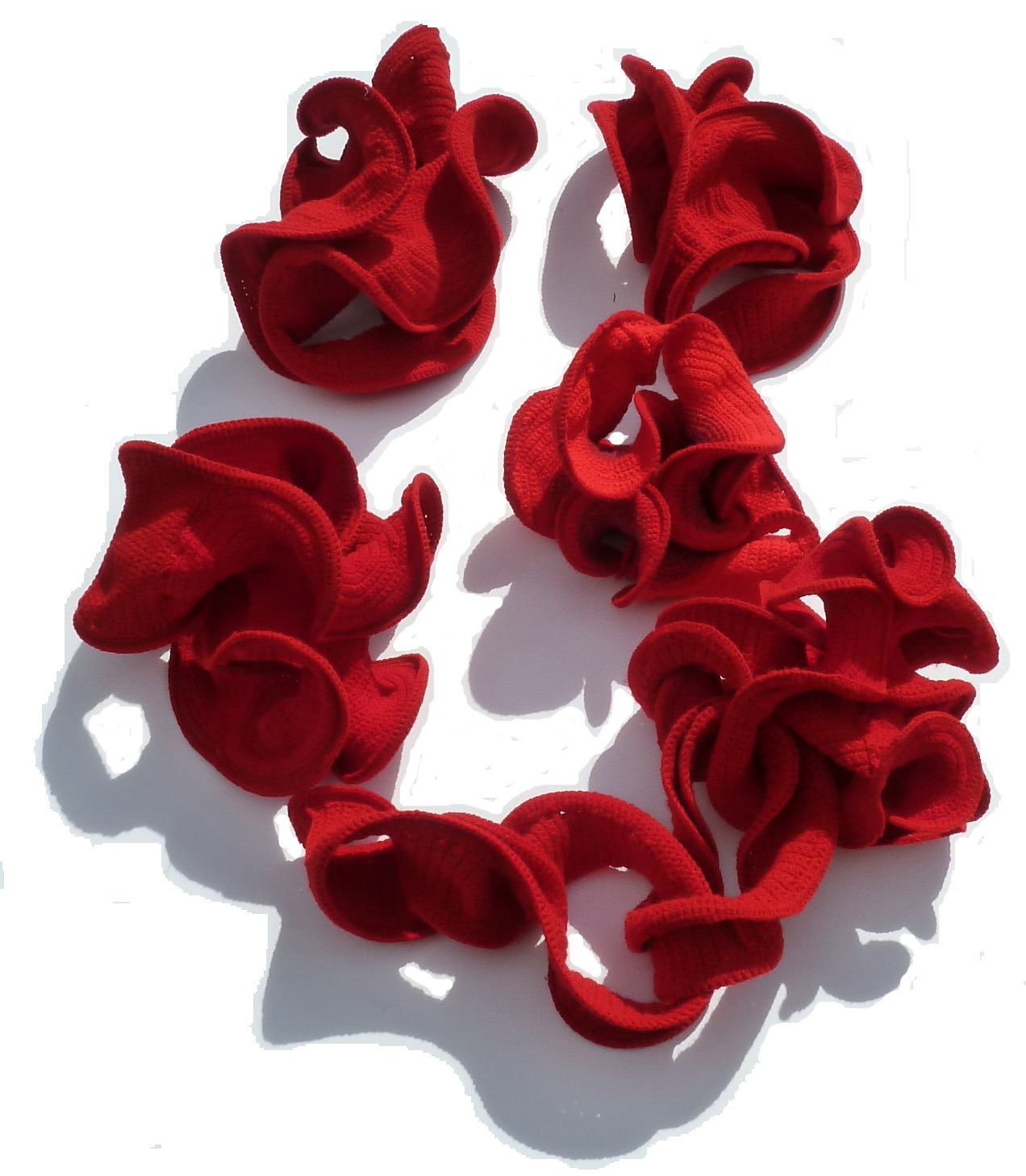
In 2004 I was invited to give a public lecture in Los Angeles. It was a challenge because I had to figure out how to tell non-mathematicians what a hyperbolic plane was. So my husband and I showed up with oranges, lettuce leaves, stones, seaweed – with everything. To show that it comes from the natural world. The lecture was a success. There were many very talented and intelligent people there, but they were not mathematicians. The organisers of the lecture, The Institute for Figuring [a Los Angeles-based initiative that promotes the public understanding of the poetic and aesthetic dimensions of science, mathematics and the technical arts – ed.], perceived the connection between hyperbolic planes and nature. The project would go on to become world-famous. Then there was Cabinet Magazine [a New York-based quarterly art and culture magazine – ed.], with which we worked very carefully to ensure that the mathematics was explained correctly.
And then came the first invitation to participate in an exhibition.
I received a call from a Washington curator [Binnie Fry – ed.] who was preparing an exhibition titled Not the Knitting You Know, which can still be seen online at eleveneleven.50webs.com. I was working in the garden when my daughter brought out the phone with the call. I was asked to send in some works and I automatically said – yes, yes. After I hung up, I started thinking – what had I promised her? What works? All of the pieces I have are covered in chalk dust, made just for use in the classroom to be used as learning aids! So I went to the local yarn shop, got some nice materials and got to work crocheting. And I really began to like what I was doing. I sent my works to the curator, she was satisfied, and they were put on display. I have an acquaintance in Washington who told me I must go to the opening. Of course I want to go to an opening, especially if it’s my first exhibition! The gallery was located on the first floor of a huge building on Massachusetts Avenue, which connects the Capitol with the White House. I showed up quite some time before the opening was to start – no one was there yet. Of course, no one knew me, so I walked through the whole exhibition, which was wonderful. But I looked at it all and thought – what am I looking for here? This is art, but in school I was told that I would never become an artist. In drawing class, I was given passable marks out of pity – so that it wouldn’t ruin my otherwise perfect grades. There were such great drawers in my class! I was just mucking about.
Well, there was a Barnes & Noble nearby, so I ordered a coffee and as I sat there I decided – I’m not going to the opening. But since I had to stay somewhere that night, and I had arranged to meet my friend at the exhibition, I had to go if only to meet up with her. But I felt very welcomed, and I met many new people there. And from then on the calls have been coming, inviting me to participate in one project after another. I continued to crochet and experiment – with colours and materials.
Colourful and rich hyperbolic contributions to “Dreams and Memories” project at RIBOCA2 by Daina Taimiņa.
Your work at the 2nd International Biennial of Contemporary Art in Riga will be called Dreams and Memories.
It is a very personal title. When I was invited to participate in the Biennial, my first reaction was – no, I don't want to. It was very soon after my husband's death. But my children said: ‘You know how happy David would be if you did it. How proud he would be of you. You have to do it.’ So I agreed, with the thought of ‘one last time’. The dreams and memories are about both of us, which really were dreams that we wanted to realise – we were both going to retire and then fulfil them. But when David retired he was diagnosed with Parkinson's, an incurable disease. We had to live with that. And we did fulfil some of our dreams; for example, we finally went to see the Alhambra. We travelled as much as we could. What do I have left? Many memories of both fulfilled and unfulfilled dreams… Yesterday’s dreams are today’s memories. This is how we all live – between dreams and memories. My personal story has resonated with many because everyone has both dreams and memories. The people I have met have been very receptive.
This crochet process...the algorithm is simple enough. You sit and move your fingers and something magical happens – the memories really do begin to stir. Just like dreams – it all comes together. I received a work from a crafter who wrote: ‘This is a very special yarn because it contains my memories of my mother-in-law, who taught me to crochet’. Another woman from Rochester wrote that she chose a particular colour because it reminds her of the snow in Riga. It turned out that she had lived in Riga in the early 1990s, and these are her memories of the snow in Riga. We discovered that we had met before – she was the founder of the Riga International Women's Club, and at that time I used to go to their ‘tea parties’. These strands of yarn seems to connect people and various times. I’ve also received works made with amazingly recycled materials that have their own ‘encoded’ stories. I still have to write something about each one.
This crochet process...the algorithm is simple enough. You sit and move your fingers and something magical happens – the memories really do begin to stir. Just like dreams – it all comes together.
The RIBOCA project involves a very large number of people – a few hundred, if I'm not mistaken?
Oh yes. Last autumn I was in Riga to organise it all and put it to launch. I already had some experience from 2014, when I created White Cloud together with the RIXC Centre for New Media Culture. I toured through Latvia that time, and it was very important with whom I communicated. For one, there are crafters who just like to do it. Then there are crafters who turn their noses up in disdain because it's too easy. But precisely because it's so simple, I tried to find and address groups of people who usually aren’t asked to collaborate with others. In this context, it is necessary to go back even further, to 2008, when the Latvian crafters’ collaborative work, From Coral Reefs to the Baltic Sea, was created [as part of the international project Hyperbolic Crochet Coral Reef, which aimed to draw public attention to the polluting of global waters and coral reef ecology – ed.]. At that time, Tija Vīksna, who organised the whole thing, had involved young people from special-needs day centres. Five of them also participated in the opening of the exhibition. They came to me and said that they wanted to understand the math ‘at the bottom of it all’. We all sat down, and it was a magical moment – it was complete concentration as they watched my fingers and I showed them what was going on there with those straight lines. When we were done, I experienced the greatest feeling of satisfaction ever. They hugged me and said: ‘Thank you for letting us feel that we are the same as others.’ I experienced something similar while working on the White Cloud project, when I went to see the visually impaired people at the Strazdumuiža Centre – they revealed that no one had ever thought of involving them in a project. I have vision problems myself, and I understood those people very well – what they felt. Therefore, my previous experience was something that I really needed in order to realise this work for the Biennial. When I was preparing the White Cloud project, I tried to bring lightness and brightness to others; this time, I had to feel that I was needed. So last November we went to schools, social daycare centres, and boarding schools for children with various disabilities with the aim of involving them. And at the same time, I gained a lot of emotional strength myself.
Daina Taimiņa. Hyperbolic Manifolds I – cotton, 2009, 30x30x20 cm
You write in your book that crochet has a healing effect.
Yes, because like knitting, it’s a meditative process. It was not for nothing that during World War II the people who hid in the London underground during the German airstrikes were advised to knit. Of course, you have to follow along with what you are doing, but at the same time, your thoughts wander in all directions. You can also watch movies while you crochet. When I was making the largest works, I said that the time to complete them should not be measured in hours but in movies.
You mentioned your large works – one of them is in the 2013 Guinness Book of World Records.
I don't know how it got in there. I don't have a certificate because you have to pay to get it and I’m rather indifferent about it. They called me when making their page on numbers and asked – is that me, do I have such a work, and can they use that particular photo of it. Just fact checking.
That work ended up sitting on our round dining table and I had to crochet as I walked around the table. It was impossible to shift the piece itself as I worked on it, and too heavy and too large to hold on my lap.
Daina Taimiņa. We are the same, cotton, 2005, 25x25x20 cm (each)
What was the reason for making such a large piece?
Because...there was an exhibition taking place in Connecticut, and I was invited to participate in a panel discussion with Bernar Venet . Venet was participating as a painter because his large-format paintings with equations were being exhibited. And on the opposite end there was me – a mathematician who makes these hyperbolic shapes. After the panel we were sitting together during lunch – Bernard, the curator Steve Rosenberg, and I. And Bernard says to me: ‘Why are your works so little? Make them big! Make one really big and we'll get it into MoMA. Your work should be there.’ But to make something that large I need materials, so I asked him: ‘Where do you get the materials you need when you make your big sculptures?’. He looks at me and says: ‘Well, the sculptures have already been bought before they're made.’ Well, that option doesn’t work for me. So I went looking for the cheapest material I could find. The pink colour of that object...to be honest, I can't stand pink. But I found my material at The Dollar Store, for a dollar per skein (normally one skein costs around four to five dollars). What a bargain! So I bought 88 skeins. Up until that day, and ever since, I have never paid with a credit card at a ‘dollar’ store. After that day the owners have always warmly greeted me when we happened to run into each other on the street.
That's how I made that piece. After that I was asked if I could make it even bigger, and I found another 38 skeins on eBay – it took me a total of two years to make it. Now it sits at home when it’s not travelling to an exhibition.
But not to MoMA?
Ha! You see, with museums in America there are still rules that say that if I give something to a museum, then it's officially a gift. I am only entitled to a tax credit for money spent on materials. That is why US museums are currently trying to get rid of this regulation – they’re having a hard time getting new works. If someone other than the artist donates a work, the donor receives a tax deduction for the entire value of the work of art. The Cooper Hewitt Smithsonian Design Museum in New York wanted to acquire this pink piece, but they stipulated that the work must be donated. I had already donated one of my pieces to the Smithsonian in Washington DC (National Museum of American History). I probably should have also given them the pink one, but back then I didn’t want to simply give away such a huge thing. They then asked me to make one specially for them, and I did. They provided the yarn – a wonderful ‘Christmas Red’. That one is also a large-format work, but it ended with me busting my shoulder. What was I to do? – I popped some ibuprofen and kept on crocheting. When the new Cooper Hewitt was reopened after construction, I received an invitation and saw my work there. Look how things have turned out – in school I was told that I would never make an artist out of myself.
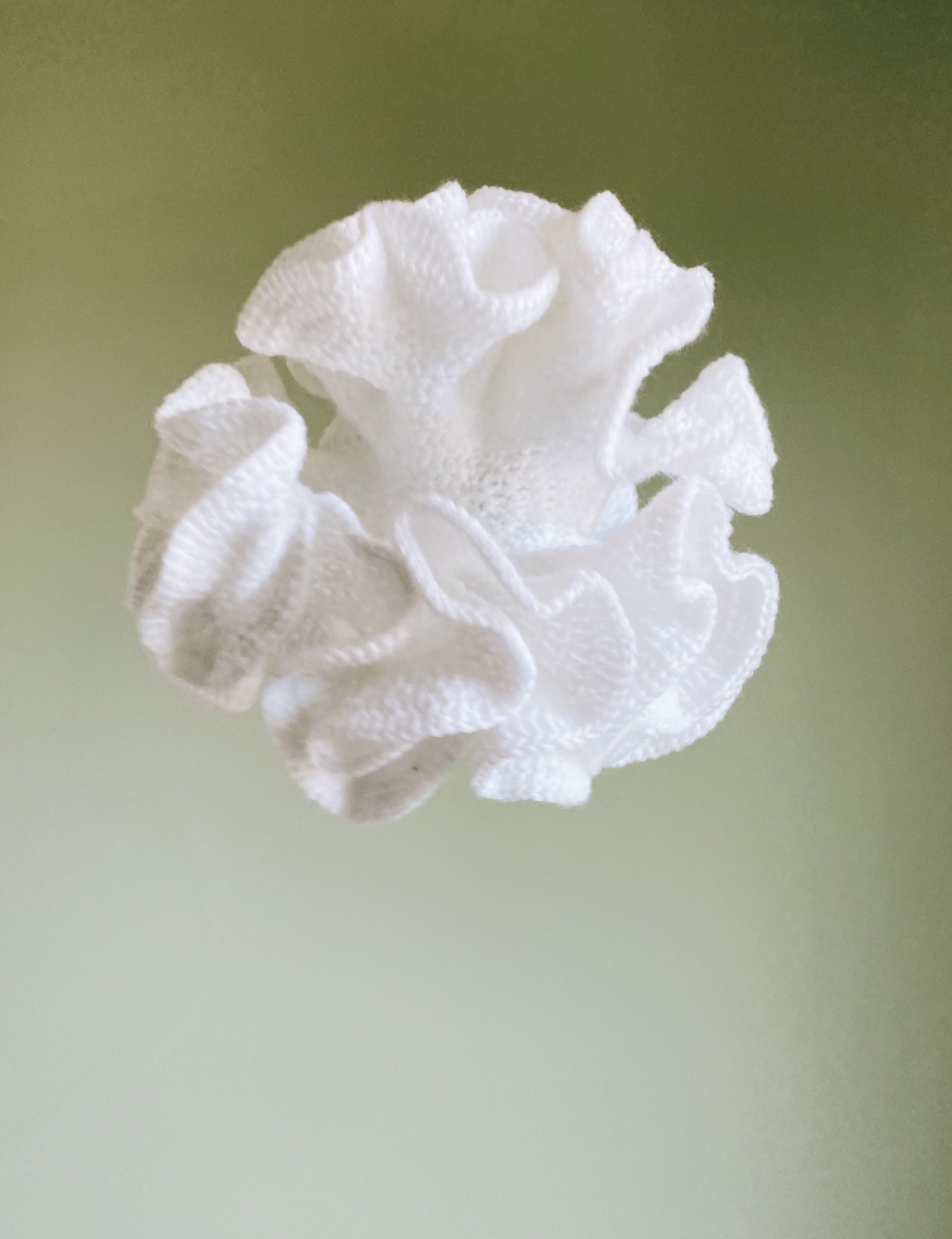
What do you think is the task of today’s art?
For me, personally, art is a conversational language. I can't abstractly create something – I need to have a conversation with the people who will see it and look at it. I create it for someone. As I mentioned, before RIBOCA I had decided that I was done with it. But what happened was just what my husband always laughed about – as soon as I say I’ve had enough, the next project comes along. And so I continue to crochet my planes. I just completed a new group – a whole Hyperbolic Garden for the Mathemalchemy project inspired by Ingrid Daubechies, one of the most popular and well-known mathematicians in the world. It is an installation where mathematics will be discovered through various art objects. About 20 people are participating in the project, both mathematicians and artists. It is intended as a project that will travel from museum to museum, showing that mathematics can also be playful, fun and colourful. Mathematics that manifests itself through art. But, in general, I don't tend to theorise through art – it's important for me to talk to people.
I must admit that when looking at your hyperbolic planes, there’s a desire to touch them. There’s a kind of...tactile necessity/desire to physically experience their shape. In museums works of art cannot be touched, unfortunately.
That's why I made another plane for the Cooper Hewitt Museum which was specifically designed to be touched. However, they have not yet put it on display in this manner. When I was making White Cloud, I also crocheted some pieces with acrylic yarn, which is machine-washable – so that people can touch it. In fact, these planes were originally designed for people to physically work with them.
I have an interesting story concerning touch. There was a major exhibition at the Triennale di Milano design museum in Milan, where I had been given a corner in which to display my planes. On opening night, when all of Milan’s design students can visit the exhibition for free, hundreds of people had gathered. A museum is a museum, after all. Here and there they assigned people to keep watch that everyone follows the rules. By my display there stood a man with a red tie who, like a mother hen, kept telling everyone: ‘Don't touch, don't touch,’ because everyone keept reaching out their hands in an attempt to feel my crocheted planes. After a few hours the crowds ebbed away, and I also left my display to see other works and meet with people. But my husband stayed and kept watch by my planes. He later told me: "I look up and see that the man in the red tie, who so diligently shooed others away from touching your planes, has stretched out his hand and is squishing them.’ It was apparently a really funny sight to see.
Daina Taimiņa. 4x100 m, acrylic yarn, 2005, 25x25x20cm
The modern education system is characterised by a sharp distinction between the humanities and the sciences, which is, in fact, quite absurd given the extent to which the world is interconnected. As we know, by looking at lettuce leaves and chanterelles one can understand the hyperbolic planes that are so popular in today’s architecture; throughout the history of art it is clear that art has always been in close communication with mathematics. Is this educational separation misguided?
Yes, it really is. You know, many people have said to me – I wish you had been my maths teacher. That was why I wrote my book Crocheting Adventures with Hyperbolic Planes. When I was working on projects with people and they came to my workshop, they said – this is so interesting, I want to know the math behind it, I want to understand why this shape is formed. This also applies to the question of the meaning of art – I think this could also be the answer to the question of Why? Why do I see it that way? Why do I feel it that way? Why is this important to me? Why do these models of mine turn out like this?
In Latvia I was a mathematics teacher – both in secondary schools and at university. And I was always accused of oversimplifying maths.
Daina Taimiņa. Hyperbolic Manifolds I – cotton, 2009, 30x30x20 cm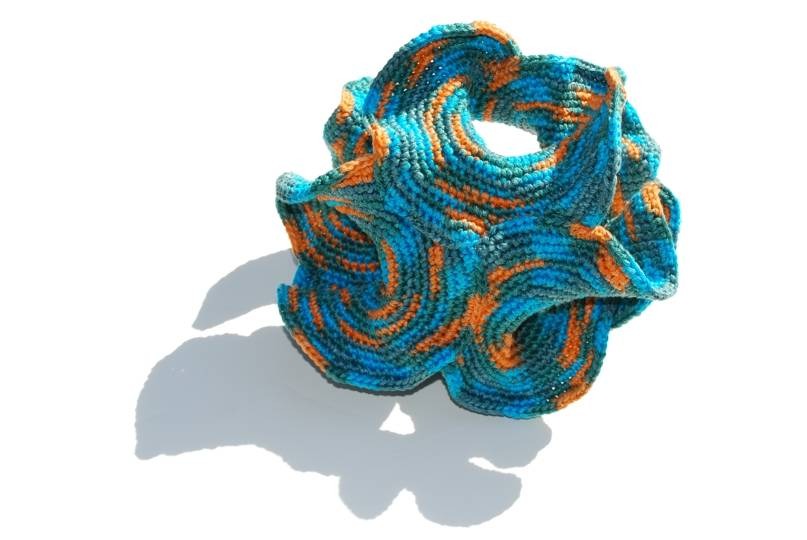
In your book you write about geometric symbols in the cultures of ancient peoples. We know that the Inca used them as a means of communication. Do you think there is cosmic symbolism or information in the traditional woven belt of Lielvārde, Latvia?
That's just poetic fancy. Ornamental symbols...this is also one of my dreams that I don't know if I will ever get to fulfill. I would like to show the geography of ornamental symbols. Latvians like to talk about Baltic ethnographic symbols and special power symbols, but I have found them in so many different places...the patterns in Latvian knitted mittens are very similar to those in Turkish socks. Symbols are geometric pictograms with which one wants to say something. There are symbols that have the same meaning in different cultures, which means that they are very old. The ‘Auseklītis’ [an eight-pointed star – ed.] was so popular during the Awakening [the third Latvian political and cultural ‘awakening’ of the late 1980s – ed.]. I have found this symbol in very different other ancient cultures which had absolutely no contact with the ancient Baltic tribes. This only proves that the representation of information with geometric elements existed before writing arose. In museums I like to find the place where the most ancient exhibits are displayed, and then there I study these symbols. I have a great number of photos of geometric symbols that I have taken during my travels. I would like to put it all together someday, especially to show how the same symbolic element can exist in different cultures. For example, ‘Jumis’ [a geometric pictogram of crossed sheaves of grain – ed.] is a symbol of fertility for both Latvians and Turks. For Latvians, ‘Auseklītis’ is a derivative of a star pictogramme, and it is also a star symbol in Native American cultures. Now here in America, various seemingly unnecessary things are being thrown out – look at this Latvian women's embroidery that I found [shows decorative throw pillows embroidered with Latvian patterns – ed.]. I'm trying to save them.
Symbols are geometric pictograms with which one wants to say something. There are symbols that have the same meaning in different cultures, which means that they are very old.
It’s pure geometry...
I know, right?
Daina Taimiņa. Global Warm(n)ing – 2008-2010, acrylic tape crochet, 75x75x55 cm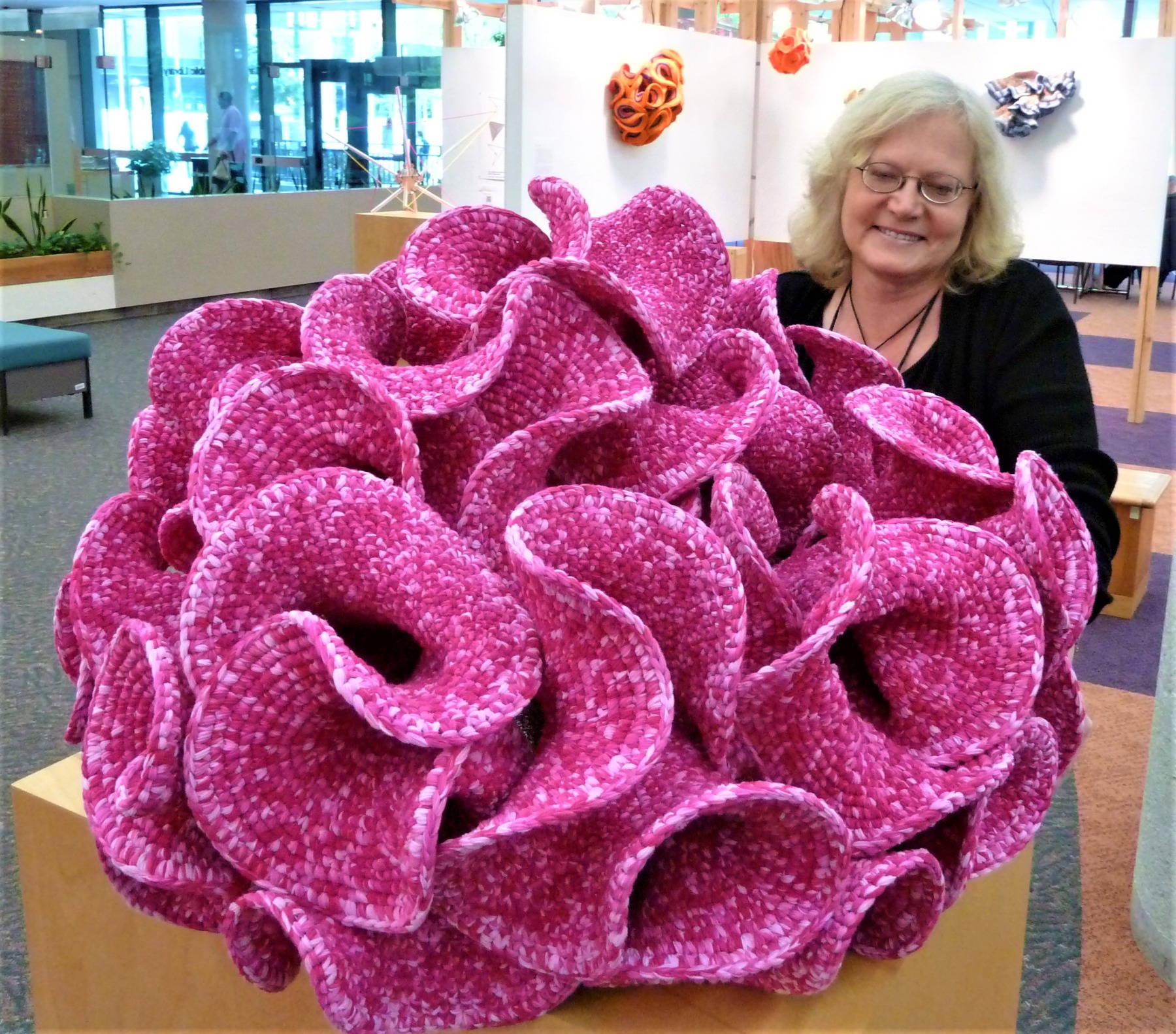
In Crocheting Adventures with Hyperbolic Planes there’s a section called ‘What Else Can Be Done with a Hyperbolic Plane?’. You also have a hyperbolic skirt.
A dress, too. It looks very beautiful when spinning. Seamstresses have been using this amount of material for centuries to create a full skirt. Hyperbolic means ‘too much’. A sheet of paper that has fallen to the ground will remain as flat as it was. Flatten an orange peel and it breaks because the surface area is too small to be flat. But if you flatten a lettuce leaf, the surface will overlap because there is too much of it. These properties are observed in various processes. I myself have learned a lot from looking where and how hyperbolic geometry is used. But there are also researchers who were inspired to use hyperbolic geometry to describe their results precisely because they had seen my crocheted models. When I crocheted my first hyperbolic plane, I couldn’t have dreamed that it would eventually become so widely known.